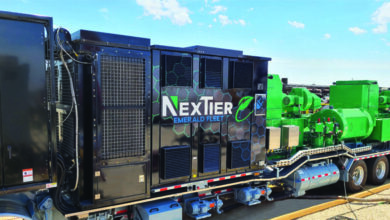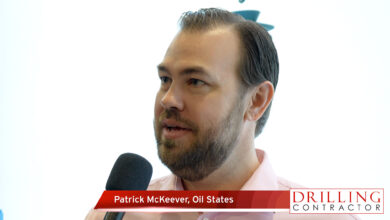Responsive, ‘self-healing’ cement technology promises to improve long-term zonal isolation
By A. Comet, A. Garnier, J. L. Presles, TOTAL; Helene Bulté-Loyer, Philippe Drecq, Sylvaine Le Roy-Delage and Iker Unanue Rodriguez, Schlumberger

A high percentage of the total number of wells worldwide leak or show sustained casing pressure (SCP). Loss of zonal isolation, especially when leaks are vented to surface, pose safety and environmental risks, as well as the loss of valuable hydrocarbons.
A solution to mitigate the risk of oil or gas leaks has been developed based on a responsive cement blend with intrinsic self-healing properties automatically activated upon hydrocarbon exposure. Combined with good well clean-up and cementing practices, this material significantly reduces the risk of loss of hydraulic isolation during production and after abandonment. The technology has been applied in several locations, including gas storage wells in the south of France.
LEAK-FREE WELLS
Several factors can affect long-term zonal isolation and prevent the achievement of leak-free wells. These include the types of cement-based material used, the slurry properties and the practices followed during placement of the cement sheath.
The mechanical properties of the set-cement are also of prime importance. Improving cement strength and optimizing slurry placement help to prevent hydrocarbon flow; however, changes in pressure or temperature can damage set cement and create a potential flow path for hydrocarbons.
Several technologies have been developed to improve the mechanical properties of the cement sheath and thus prevent cracks and microannuli in stressful downhole environments. While all such methods increase the resistance of the cement matrix to physical stresses, none can accommodate problems that occur once the cement sheath has actually failed and becomes permeable.
A new self-healing cement (SHC) technology has been developed, to mitigate the risk of oil or gas leaks in the event of damage to the cement sheath.
SELF-HEALING CEMENT
The self-healing cement technology, FUTUR active set-cement technology, uses a responsive material where the repair mechanism is automatically activated upon exposure to hydrocarbons, to repair leaks when and where necessary. The set material enables automatic repair when a microannulus or internal cement cracks are created, thus preventing flow of formation fluids through potential leak paths along the annulus.
The self-healing action is repeatable if annular integrity is further compromised during the long-term productive life of the well. If the SHC system is not exposed to hydrocarbons, it remains in place and acts as conventional cement. Use of this new system results not only in a reduced risk of remediation costs and associated lost production, it also increases the well’s potential productive life and addresses possible strengthening of future environmental regulations.

SHC SLURRY DESIGN
Along with self-healing additives, SHC slurry formulations contain conventional additives, such as dispersant, antifoam, retarder, fluid loss control agent and, if necessary, gas migration control material. The material is mixed and tested like conventional cements. Standard tests include measurements of rheological properties, free fluid, slurry stability, fluid loss control, thickening time, and compressive strength development, measured by an ultrasonic cement analyzer.
The self-healing properties of the SHC technology have been demonstrated with several reservoir oils and with hydrocarbon gas. Properties of the SHC slurry and mechanical properties of the set cement are comparable to conventional systems. Today, commercial SHC slurries are available at densities from 1,440 kg/cu m to 1,920 kg/ cu m (12 to 16 lbm/gal). Temperature application ranges from 20° to 138°C (68° to 280°F).
WORLDWIDE APPLICATIONS
SHC slurries have been pumped in several locations worldwide where issues with gas leaks were identified as a risk. The technology was applied in several wells in an area of western Colorado known to have problems with gas leaking to surface after the cement sheath had set. These leaks eventually forced a suspension of drilling operations and a re-evaluation of cementing practices. After application of the SHC material, the incidence of leaking wells in this area fell to nearly zero.
The SHC system has been applied in two wells in the Stolberg field in the central Alberta foothills region to address SCP and surface casing vent flows. More than three years after implementation, the wells have shown no signs of pressure buildup in the annulus or at surface.
The technology was also used for well construction as part of a gas field development in Algeria, where wells had developed surface casing leaks days or weeks following cementing operations. The application of the SHC system has reduced the occurrence of these leaks.
Self-healing cement technology has also been used to enhance zonal isolation in underground gas storage (UGS) wells in several countries, mitigating the risks of leaks that could impact the environment and reduce the storage capacity of these wells.
UGS
Underground gas storage systems are gaining importance in many countries. They help suppliers maintain inventories of natural gas and reduce the risk of interruptions that might result from technical, political or other problems. The most common type of UGS facility is a depleted gas reservoir. Drilling activity is growing to increase storage capacity.
A major challenge faced during the operation of UGS wells is the maintenance of wellbore integrity over the short and long term. Underground storage wells often cross multiple depleted hydrocarbon zones that can still produce gas. They must also tolerate high injection pressures, high production rates, and frequent changes in pressure and temperature.
These wells have long lifetimes (80 years or more) compared with oil and gas production wells. Sustained casing pressure within the annulus can compromise the integrity of a UGS well. Sustained casing pressure can be caused by tubing and casing leaks, or damage to the cement sheath resulting from thermal and pressure loading. It can trigger gas leakage, either through the sheath or through burst or collapsed casing and tubing.
Many UGS fields are strategically located close to large urban cities, where HSE regulations require leak-free wells. Consequently, SCP can lead to premature abandonment if there is gas leakage.
Self-healing cement technology has been used to enhance zonal isolation in UGS wells in France, Germany and Italy. Results to date indicate that the technology is highly effective. For example, logging of well Cortemaggiore 155dir, Italy, indicates optimal cement bonding to casing and to formation, providing hydraulic isolation across permeable zones and thus safe operation for gas injection and production.

UGS CASE HISTORY
In 2008, French regulatory authorities allowed an increase in the storage capacity of a UGS site near Lacq in the south of France. The reservoirs are aquifers converted into natural gas storage facilities, which can store large amounts of natural gas at sufficiently high pressure without lateral or upward leakage.
This case study concerns well Le Houga 1. A tailored SHC system was designed to mitigate expected risks, and a comprehensive study was run to prove the self-healing properties with the composition of the gas to be injected in the reservoir. Tests were performed on the selected slurry composition in the Schlumberger Riboud and Product Center in Clamart, France, and in the Schlumberger Reservoir Fluids Center in Edmonton, Canada.
LABORATORY TESTS
A testing system, based on a Hassler sleeve-type core holder, has been developed to study the effectiveness of the SHC at preventing gas leakage after simulated failures of the cement matrix under realistic reservoir conditions. Two types of failure are simulated: Either the cell with the cement is cured and dried in such a way that a microannulus is created due to drying and shrinkage, or a cylindrical cement sample is fractured along the longitudinal axis in two parts and placed back into the cell.
During the flow tests, gas is injected at a constant rate, and the resulting differential pressure across the sample is measured. This differential pressure value is directly related to the size of the microannulus or crack. An increase in differential pressure during the test indicates that the SHC material has swollen in the presence of the gas to reduce the size of the flow path.
In a first step, non-reactive Nitrogen gas is used to quantify the width of the micro-annulus or crack. Hydrocarbon gas is then injected to activate the repair mechanism.
Laboratory tests on several SHC slurries confirm that the matrix exhibits self-healing properties and reduces flow rate when exposed to hydrocarbon gas under dynamic conditions and under pressure. Similar tests on cement systems without self-healing additives show no decrease in flow rate.
The slurry design for well Le Houga 1 had a density of 1,440 kg/cu m and a low fluid loss of 10.7 mL API. Results from measurements using a Hassler sleeve confirm a low permeability of 286 nano Darcy for the set cement. Tests with hydrocarbon gas indicated excellent performance (Figure 1).
Tests have also been performed to confirm the long-term matrix integrity and the preservation of the self-healing properties of set SCH materials. These tests have shown that matrix integrity exhibits no deterioration in mechanical properties after one year of exposure in oil. Aging tests in hydrocarbon gas have shown that self-healing properties are kept after extended curing in water and a 320-day dormant period (Figure 2).
SLURRY PLACEMENT
In addition to SHC technology and appropriate slurry design, good clean-up and cement placement practices are essential to minimize risks to long-term well integrity.
The slurry must be possess the correct density and rheology to successfully displace spacers and drilling fluids. Spacers must, in turn, provide adequate separation between the cement slurry and the drilling fluid, as well as properly displacing drilling fluid from the annulus.

The pipe centralization program for well Le Houga 1 was reviewed to ensure that optimum stand-off could be achieved (Figure 3). As the section was near-vertical, a minimum number of centralizers were required to assure all fluids would flow evenly around the casing. Density of the weighted spacer was based on the drilling fluid weight and maximum hydrostatic pressure that the formation could withstand during displacement.
Densities, as well as the rheological properties of the fluids, were optimized to ensure that the fracture gradient was not exceeded during cementing.
An annular fluid placement simulator was used to determine mud removal efficiency and effective fluid displacement of spacers and slurries used when cementing in the casing (Figure 4). The SHC slurry was mixed and pumped with a standard continuous mixer. Amount of equipment and personnel was identical to that for previous operations.
RESULTS
Since the first application in January 2008 of FUTUR active set-cement technology in this UGS development area, three further wells in the area have been successfully pumped.
The wells have been closely monitored over time and shown no sign of leakage. The SHC material has been evaluated with ultrasonic cement evaluation tools, as well as traditional CBL-VDL logging tools. Logging indicates optimal cement bonding to the casing and to the formation, providing the assurance of effective hydraulic isolation and thus safer operation for these UGS wells.
IADC/SPE 128226, “Self Healing Cement System – A Step Forward in Reducing Long Term Environmental Impact,” was presented at the 2010 IADC/SPE Drilling Conference & Exhibition, 2-4 February, New Orleans, La.
FUTUR is a mark of Schlumberger.
References:
Bourras H., Doumaz N., Bellabarba M., Caceres E., Gamal Abd-El Aziz M., Mananga S., Le Roy-Delage S. and Rebbou Benberber M., “Responsive Cementing Material Prevents Annular Leaks in Gas Wells,” SPE 116757, 2008 SPE Annual Technical Conference and Exhibition, Denver, Colo., September 2008.
Cavanagh P., Johnson C.R., Le Roy-Delage S., DeBruijn, G., Cooper, I., Guillot, D., Bulte-Loyer, H. and Dargaud, B., 2007. “Self-Healing Cement – Novel Technology to Achieve Leak-Free Wells,” SPE 105781, SPE/IADC Drilling Conference, Amsterdam, 20-22 February 2007.
Moroni, N., Panciera, N., Johnson, C., Le Roy Delage, S., Bulte-Loyer, H., Cantini, S., Belleggia, E. and Illuminati, R., 2007. “Overcoming the Weak Link in Cemented Hydraulic Isolation,” SPE 110523, SPE Annual Technical Conference and Exhibition, Anaheim, 12-14 November.




